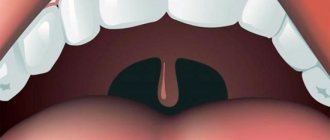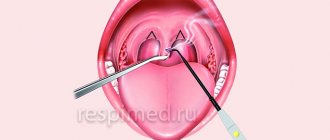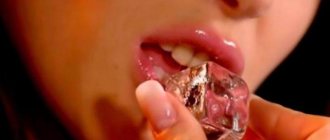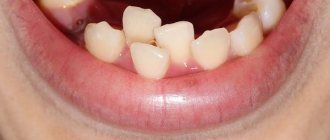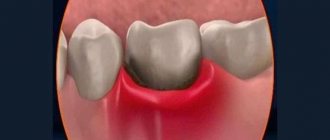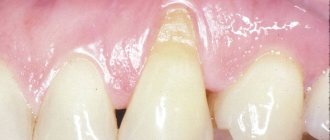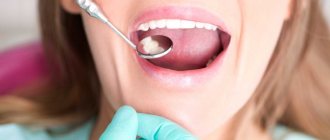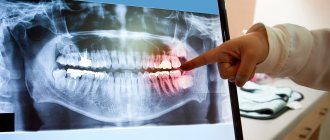.
The tongue is an important organ in the human body, but it is remembered only when it begins to hurt. The tongue can get sick not only from infection, but also from mechanical stress. What does it mean? The tongue rubs against the uneven edges of the teeth.
The most common situation is the chipping of a small section of a tooth. Such a nuisance can happen to anyone. As a result, the uneven edges of the tooth begin to cause discomfort, interfere with normal eating and cause pain during conversation.
Wounds on the sides of the tongue - marks from teeth
If you delay treatment of an injured tongue for a long time, you can get serious inflammation, which can lead to infection of the entire oral cavity.
Causes
Calluses are often confused with stomatitis and pemphigus. This comparison is incorrect, since the main reason for the appearance of calluses is systematic trauma to the oral cavity.
In infants, injury occurs during feeding, especially if it is carried out not according to time, but at the request of the baby, and he remains at the breast for a long time. Rubbing of the thin mucous membrane occurs, as a result of which seals can appear not only on the tongue, but also on the palate and upper lip.
Adults suffer from the pathology most often after eating seeds, nuts, chewing candy and other hard foods. They may develop calluses on their gums or the roof of their mouth from wearing braces.
If wisdom teeth erupt incorrectly, sores may appear on the inside of the cheeks due to constant trauma.
A callus forms on the tongue after carelessly consuming hot food or drinks. Trauma to the mucous membrane occurs, which leads to tissue necrosis.
Symptoms
Externally, a callus looks like a compaction or a blister filled with liquid, it all depends on the nature of its occurrence.
In children, the formation looks like a blister; after a rupture, a whitish compaction appears in its place. In adults, the callus may have the same appearance; if it ruptures, there is a high risk of developing a small ulcer.
As a rule, patients do not feel any discomfort, their body temperature does not rise and fever does not occur. In general, such a formation is not dangerous; it requires special attention if it ruptures, since there is a high risk of infection in the wound.
Sore tongue in children
In most cases, neoplasms on the tongue in children are fungal, which are called thrush. This pathology occurs as a result of insufficient oral hygiene in a child.
In this case, the tongue becomes dry, colored bright scarlet. Initially, whitish tubercles form on it. As thrush progresses, they turn into a film that “covers” the entire tongue completely. It can be removed quite easily. In this case, small erosions may form on the organ.
Drug therapy
The main goal of treatment is to prevent the infectious process at the site of the burst callus. The fact is that pathogenic microorganisms can quickly infect the deep layers of the mucous membrane and lead to infection of the oropharynx.
If a callus is detected in infants, it does not need to be treated; it will go away on its own after stopping breastfeeding. If the formation ruptures, you can treat the tissue with three percent hydrogen peroxide . The use of iodine or brilliant green is not recommended, as they can severely dry out the thin mucous membrane.
Adults can rinse their mouths with antiseptics, for example, Chlorhexidine. You should use mouthwash after every meal. It is also recommended to take a vitamin complex to strengthen the body's defenses.
If, after spontaneous opening of the callus, the patient feels increased pain, has an increase in temperature and general weakness, he should immediately consult a therapist. These symptoms may indicate the development of a bacterial infection, which in severe cases leads to the formation of purulent abscesses.
Traditional treatment
If a lump is found in a child, it is not recommended to resort to using any folk remedies on your own, as they can negatively affect the baby’s condition.
For adults, rinsing with antibacterial compounds is perfect. They will help prevent the development of inflammation in the injured area of the mucosa, and will also help maintain the cleanliness of the oral cavity. An important addition: you can use traditional methods only if there are no allergic reactions to herbs. Otherwise, it is better to refuse alternative treatment. The most effective recipes are described below:
- Salt rinse. To do this, dissolve a teaspoon of sea salt in a glass of warm water. Rinse your mouth after eating; after treatment, you should stop eating for at least an hour.
- Chamomile decoction. It is most convenient to use ready-made filter bags, which are sold at the pharmacy. You need to fill one such packet with a glass of boiling water, let it brew and use it to treat the oral cavity.
- Calendula. For this rinse you will need an alcohol solution. Twenty drops of tincture are dissolved in a glass of warm water and used after any meal, preferably before going to bed.
- Propolis. This beekeeping product has excellent antiseptic and healing properties . It is used in the amount of one teaspoon per glass of warm water.
The above recipes are not only effective, but also affordable, and if used regularly, they will help to avoid infection of the oral cavity.
Prevention
It is impossible to prevent the occurrence of calluses in the mouth in infants. As long as breastfeeding or artificial feeding continues, the delicate mucous membrane will be involuntarily injured. It is necessary to regularly examine the child’s oral cavity and prevent foreign objects or insufficiently clean toys from entering.
If there are suspicious symptoms, such as an increase in the number of calluses, a change in their color and structure, or a deterioration in the baby’s well-being, you should immediately consult a pediatrician. The fact is that the oral mucosa is the first barrier to pathogenic microorganisms, and a violation of its integrity threatens the occurrence of an inflammatory process, the treatment of which can take a long time.
Reasons for the development of pathology
Damage can be caused by several direct or indirect factors. Determining the cause is an important aspect for proper treatment. Among these factors:
- Mechanical damage due to trauma.
- Chipping due to bad habits (biting nails, pens, and other objects not intended for this purpose).
- Reduced acidity of the oral cavity, which negatively affects the strength of enamel.
- Bite defects.
- Dental pathologies that have not received treatment.
- Remineralized enamel.
- Hormonal imbalances, changes during pregnancy.
- Frequent consumption of excessively hot or cold foods.
- Night grinding of teeth.
Tongue traumatism: theory
Before you begin treatment of the tongue, you should carefully study the nature of the injury and its causes.
The first type of damage - mechanical - is the most common cause of tongue injuries. Due to mechanical damage, ulcers and superficial erosions form on the tongue.
Conditions under which mechanical injuries occur are of a domestic nature:
- damage to the integument by dental instruments - probe, bur, disc;
- the occurrence of a wound under the influence of a sharp object - a bone, a knife, a fork;
- biting the tongue while eating, epileptic seizure;
- the appearance of tongue injuries from blows to the face.
Healing of a wound caused by mechanical impact occurs depending on the depth and area of damage to the mucous membrane.
Chemical burn
Chemical injury to the tongue, as the second type of injury, occurs due to contact with the mucous membrane of a chemical substance of an acidic or alkaline nature.
Under the influence of an irritant, chemical burns occur on the tongue. The latter are characterized by the appearance of dark-colored areas, scars, blisters and blisters on the tongue (in severe cases).
Instant rinsing of the mouth with solutions with neutralizing properties is the key to rapid restoration of the integument.
For chemical burns, it is preferable to seek help from medical institutions.
Damage to the mucous membrane by steam, hot water, fire, electric current or ionizing radiation is called physical trauma to the tongue.
Characteristic of this type of injury is pain that gradually subsides from the moment of injury.
The main danger of physical injury is the development of acute catarrhal glossitis (inflammation). Consultation with a doctor in complex stages of injury is mandatory.
Deep damage to the tongue caused by various kinds of external irritants can be accompanied by complications: abscess or phlegmon of the tongue.
Painful swelling and accompanying difficulties with swallowing and speaking are symptoms of an abscess. In later stages, with increasing inflammation of the tongue, the abscess turns into phlegmon. The victim requires emergency hospitalization and surgical intervention.
Installing a crown on a chipped tooth
In case of significant injuries, if it is impossible to restore the crown part of the tooth, a new tooth can be obtained using prosthetics. The prosthesis - crown - is fixed on the root of the tooth if this part remains healthy and strong. Different types of crowns are used depending on the material of manufacture:
- Metal ceramics are the most inexpensive option. The design is durable due to the metal base, and aesthetic due to the ceramic layer. Such dentures become an ideal option for budget restoration of teeth in the chewing area. Installation of metal ceramics in the frontal area is possible, but the tooth will not look natural due to the lack of transparency.
- Zirconium dioxide is a modern high-tech material that has both the strength and aesthetics of natural teeth. Such crowns are made using computerized technology and are practically indistinguishable from natural teeth in appearance. They refract light correctly and have a certain degree of transparency, similar to tooth enamel.
- Ceramic crown. This option is only suitable for the front teeth, since the structure is not strong enough to withstand the full chewing load. Ceramics look very aesthetically pleasing.
Treatment Basics
As mentioned earlier, treatment for tongue injuries depends on the nature of the injury. While a home first aid kit is sufficient to heal superficial injuries, eliminating the consequences of traumatic factors in case of serious injuries requires, first of all, consultation with a doctor who will select the necessary medications and prescribe recommended procedures.
What to do depending on the type of injury:
- The standard method of treatment or initial treatment of mechanical injuries is the use of antiseptics (alcohol, iodine, brilliant green). Rinsing with disinfectants helps in restoring the mucous membrane: furatsilin, hydrogen peroxide, potassium permanganate dissolved in water in a ratio of 1 to 3000 or baking soda at the rate of 1 teaspoon per 250 ml. Do not neglect plant decoctions with calming properties.
- Knowledge of chemical neutralizing reactions will be useful in case of chemical burns, because the “golden rule” of first aid for this is as follows: rinse with a neutralizing solution. Timely implementation of the necessary procedures will avoid further treatment. Blisters appearing on the tongue indicate severe damage. Opening of formations with subsequent processing should only be carried out by specialists. After neutralizing the blisters, doctors most often prescribe rinsing the mouth with disinfectants.
- Profusely bleeding wounds require immediate tamponade. It is unacceptable to independently remove foreign bodies from ulcers.
Having diagnosed the exact cause of pain in the tongue during an in-person consultation with a doctor, you can begin complex treatment.
Burning pain on the tip of the tongue of vegetative-vascular origin requires the administration of B vitamins and sedative correction. To relieve severe pain, local analgesics and novocaine blockade are recommended. Glossalgia, which develops against the background of iron deficiency, often occurs with a decrease in the sensitivity of the tongue receptors. To eliminate iron deficiency anemia, appropriate medications are prescribed.
An injection of nicotinic acid and no-spa will help improve microcirculation inside the capillaries. Transnasal electrophoresis has proven itself well in treating this problem. Positive dynamics are observed with the use of a galvanic collar.
Tranquilizers and sedatives are prescribed to people suffering from nervous disorders and panic attacks. Psychoanalysis plays an important role in the treatment of glossalgia. On its basis, autogenic training and even a hypnotic session are developed for the patient.
An effective method of treating this pathology is acupuncture, which can reduce the impact of neurological disorders that are not amenable to traditional treatment. Speech organ pain complicated by paresthesia is treated with laser therapy.
Traumatic stomatitis of the oral cavity - the result of soft tissue injury
Any injury can sooner or later lead to serious delayed consequences. And although getting an injury to the oral cavity is more difficult than hitting a limb, damage to the teeth, gums, cheeks and tongue is not uncommon. The consequence of injury can be various diseases; in this article we will look at one of the options - traumatic stomatitis. From the article you will learn what the causes and symptoms of this disease are, as well as how it can be diagnosed and treated.
Prevention of dental diseases
A number of simple steps will help the patient keep his teeth healthy for as long as possible and reduce the likelihood of diseases:
- Careful hygiene, brushing teeth at least twice a day.
- Using dental floss and rinsing with special solutions.
- Attention to the condition of soft tissues and gums.
- Timely visit to the dentist if alarming symptoms appear, preventive examinations twice a year.
How to pull a tooth at home without pain
How to relieve toothache at home
What it is
Damage to the oral mucosa can be caused in a variety of ways. In a healthy person, minor injuries disappear quite quickly and without leaving a trace. In the presence of chronic diseases that reduce the level of immunity, any infection or dirt that gets into the wound provokes the development of inflammation.
Traumatic stomatitis is the result of a single or long-term impact on soft tissues, as a result of which painful formations appear in places of damage that are not characteristic of the normal state of the mucous membrane. These may be small blisters, ulcers, erosions, ulcers or wounds covered with a grayish or white coating.
Most often, with a single exposure and the absence of infectious contamination, such consequences of injury disappear quickly and without drug treatment. If soft tissue injury occurs over a long period of time (by braces, a sharp tooth fragment, tartar, dentures, etc.), gum inflammation and stomatitis can develop into a chronic form.
Causes
The causes of traumatic stomatitis may be the following:
- In children, this phenomenon is most often associated with active games and damage to the tooth or soft tissue as a result of a blow (for example, with a ball) or an unsuccessful landing on a hard object. However, this disease can also occur in infants as a result of injury to the gums by a protruding tooth.
- In the everyday life of an adult, the main cause of the onset of stomatitis can be a simple burn from hot tea. And if a person consumes very hot food and drinks systematically, such a burn and, accordingly, stomatitis, become chronic. By the way, you can get burned not only by hot food, but also by chemicals and medications used not according to instructions, acids, alkalis, and even electric shock and fire. In addition to a burn, stomatitis can also be caused by frostbite.
- Constant friction against the sharp edge of a chipped or broken tooth, poorly ground metal of braces, or poorly fitting dentures can also cause traumatic stomatitis. It is for this reason that you should not endure discomfort and pain due to the problems described above. The only correct solution would be to contact a dentist to eliminate the interference.
Another reason for the occurrence of this disease is bad habits, as a result of which the mucous membrane is injured:
- biting lips and inner cheeks;
- frequent consumption of seeds, which injures the tongue;
- haste in eating with frequent biting of the cheeks and tongue;
- the habit of holding sharp objects in the mouth and much more.
All these mechanical effects lead not only to permanent injuries to soft tissues, but also to the formation of swelling, inflammation and even ulcers.
Causes of chafing
The cause of tongue rubbing can be not only a broken tooth, but also other factors:
Poorly placed filling. Low-qualified specialists in inexpensive clinics sometimes treat their work with negligence. As a result, the placed filling has uneven edges. All excess material slowly begins to cause discomfort in the mucous membrane of the tongue. Sometimes this rubbing reaches the muscle organs.
Uncomfortable dentures. Some people wear dentures, but they can sometimes be uncomfortable. At the initial stage of wearing, a complex orthopedic design can injure the entire oral area. Inconvenience is caused by a poorly polished surface, large prosthetic elements and locking joints.
An uncomfortable denture can hurt your gums and tongue.
Symptoms
Traumatic stomatitis can be distinguished from other types only by knowing the background of its occurrence, since the manifestations of symptoms of the disease are quite typical for all types:
- At the site of injury, a slight swelling or bruise first appears, the skin turns red, swells, and slight tissue hyperemia may appear;
- gradually the painful sensations increase, over time it becomes difficult to open the mouth and chew food;
- ulcers, wounds, ulcers, blisters, erosions appear;
- with severe lesions, irreversible soft tissue necrosis may occur;
- as a result of an acid burn, a dense film forms over the damage;
- until the cause of injury is eliminated, the manifestation of symptoms of stomatitis can be wave-like;
- Severe cases of traumatic stomatitis may be accompanied by suppuration or fungal infection.
Treatment
Like any serious disease, traumatic stomatitis requires immediate treatment. First of all, the doctor will have to eliminate the source of injury:
- In the case of a broken or chipped tooth, it is necessary to cure or remove this tooth, depending on the depth of the damage.
- Braces and dentures are improved or remade from higher quality material.
- Tartar is removed and the sharp edge of the tooth is ground down.
- If there are minor injuries, wounds and cracks are washed with antiseptics (peroxide, furacillin, infusions of calendula or chamomile).
- More serious injuries are numbed and treated with anti-inflammatory drugs.
- For quick healing of wounds, ulcers and erosions, your doctor may recommend applications with rosehip or sea buckthorn oils, vitamin A oil solution and other keratoplasties.
- In cases of thermal burns or frostbite, applications of an anesthetic drug may be necessary, but in case of a chemical burn, you must first thoroughly rinse the damaged area with a neutralizer. For an acid burn, use an alkali solution, and for an alkaline burn, accordingly, use an acid solution. And only after eliminating the traumatic substance is further treatment with antiseptics and anesthetic rinses possible.
Microprosthetics for tooth restoration
To restore the aesthetics and full function of a damaged tooth, restoration is used. If the chip is small, the problem can be solved using composite materials. For more significant damage, microprosthetics would be an excellent option. Inlays, which serve as microprostheses for restoring teeth, are made from composite materials based on an impression. They are durable and aesthetic, and are widely used in modern dentistry.
Micro-prostheses also include veneers. These are thin plates that are attached from the outside to the prepared teeth (in the frontal zone of the dentition, covering the front part and lower edge of the tooth). Veneers are also made from impressions and are effective in correcting most aesthetic problems. The plates are mainly made of ceramics and zirconium dioxide.
If the injury affects the pulp, the specialist treats the canals, and then fills or installs a microprosthesis.
A tooth has chipped and your tongue is scratching: what to do?
First of all, you should evaluate the degree of chipping and the condition of the tooth as a whole. Small chips in the enamel will wear off on their own in a few days. They usually do not pose any danger to a healthy tooth and oral cavity; minor wounds and abrasions from scratching the cheek or tongue heal quickly.
To treat a sharp area of the tooth, it is better to seek help from a dentist. The doctor will file it with a drill and cover it with a special agent. If the area of the chip is large, then most likely, restoration or even prosthetics of the tooth will be required.
In cases where going to the doctor is impossible, and a broken tooth is very annoying, you can try to treat it with improvised means. For such purposes, a file with a fine abrasive, a glass nail file, or the finest sandpaper may be suitable.
Pre-treat any of these items with alcohol or any disinfectant solution. You need to act very carefully so as not to damage the enamel and gums. This method is extreme and its use is highly undesirable.
If there is caries in a broken tooth and dark spots are visible at the chip site, then you need to see a doctor as soon as possible. The dark color of enamel and dentin indicates that an active process of tissue destruction has begun and without timely filling or prosthetics, the tooth will continue to chip and will have to be removed.
If a tooth breaks off below the gum level, the discomfort will be very intense. Often this happens due to serious facial trauma. A deep chipped tooth can severely injure the gums and even expose a nerve. If you can’t see a doctor quickly, you should often rinse your mouth with a decoction of chamomile or sage, and also take a pain reliever. Only a visit to the doctor can decide what to do next with the tooth.
Should I treat or remove my wisdom tooth?
Wisdom teeth almost always cause a lot of trouble and doctors often advise removing them immediately, since they can have an atypical location and cause significant discomfort during eruption. But what to do when a wisdom tooth breaks off: treat it or remove it? In this situation you need to think carefully. If the tooth is of normal shape and has grown correctly, then it is completely unnecessary to remove it. Like all other teeth, the wise tooth can be treated, restored and even prosthetically fitted, because, as you know, there are no superfluous teeth.
Any of the situations described above is quite unpleasant. Therefore, the main task is to prevent chipping of teeth and enamel. Proper oral hygiene and timely visits to the dentist can significantly reduce the risk of chipping the tooth wall. Also, life situations in which mechanical damage to the jaws and teeth in particular can occur should be minimized.
In addition, it is worth paying attention to the foods you eat and, if possible, excluding those that may be too hard or potentially dangerous because, as you know, the condition of the gastrointestinal tract and the entire body as a whole depends on the health of your teeth.
Activities before visiting the dentist
Depending on the extent of the damage, the patient may feel discomfort from increased sensitivity and pain. If a sharp edge is formed after the chipping, it will scratch the gum, tongue, and cheek. Such damage is a favorable environment for infection. The sharp edge must be isolated as soon as possible. A tooth that has lost full enamel protection is also vulnerable to infection.
While waiting for a visit to the dentist, the patient can take a number of actions to minimize negative consequences:
- Do not put any pressure on the affected tooth or chew hard food on its side.
- Thoroughly clean the chipped area, avoiding the accumulation of food debris and plaque.
- Rinse with a soda solution (you can add iodine and salt).
- If your chipped tooth hurts, you can take a pain reliever.
PROMOTION
Hygienic teeth cleaning
2000 rub.
